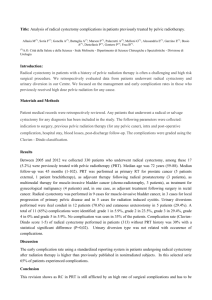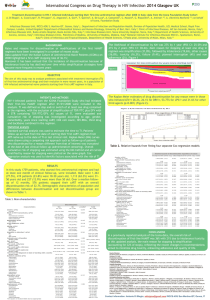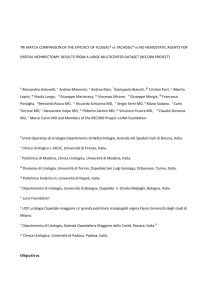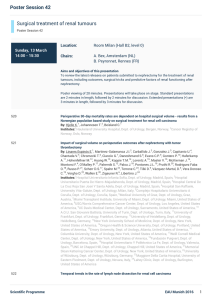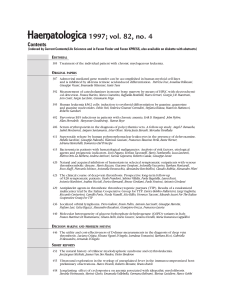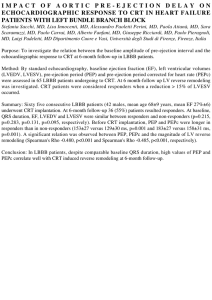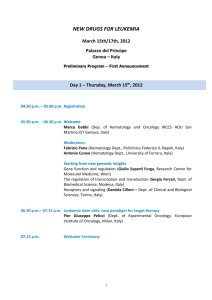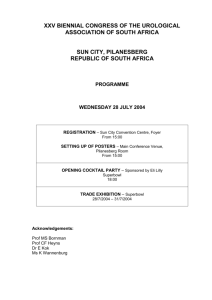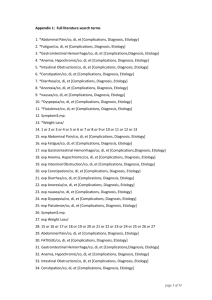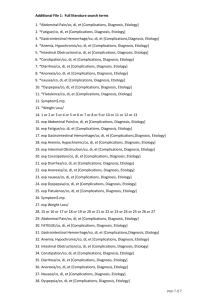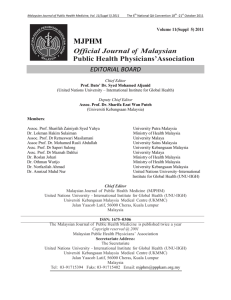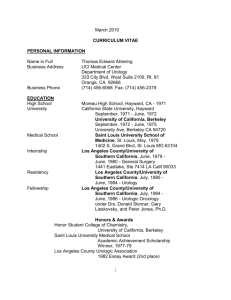Operative time is associated with an higher incidence of post
advertisement
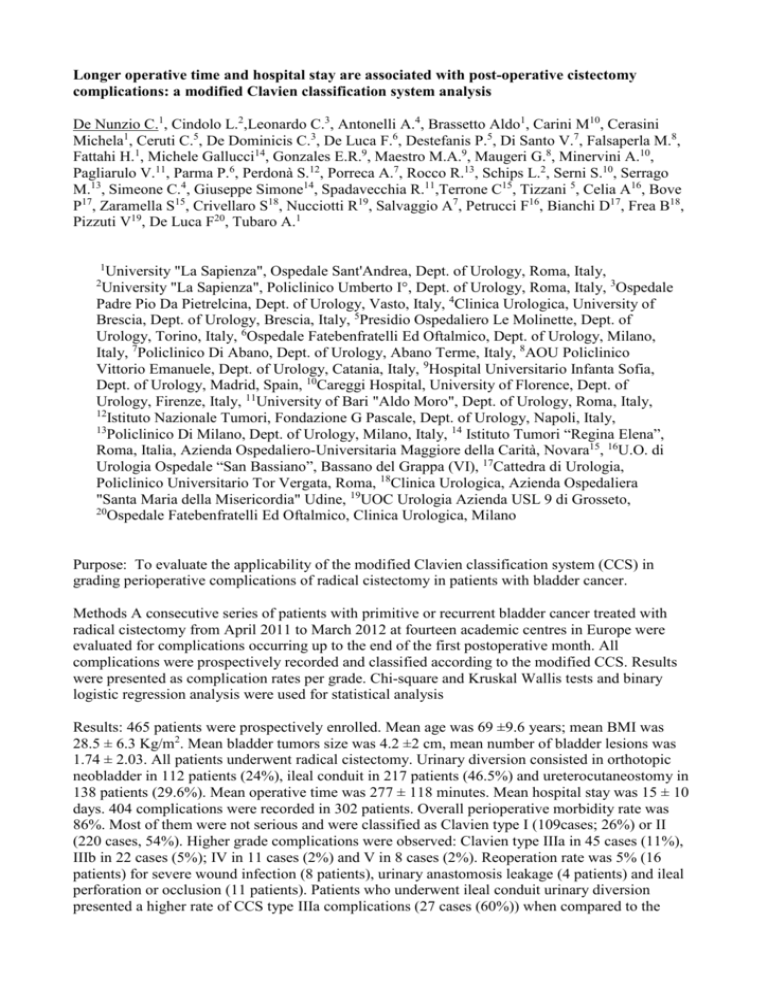
Longer operative time and hospital stay are associated with post-operative cistectomy complications: a modified Clavien classification system analysis De Nunzio C.1, Cindolo L.2,Leonardo C.3, Antonelli A.4, Brassetto Aldo1, Carini M10, Cerasini Michela1, Ceruti C.5, De Dominicis C.3, De Luca F.6, Destefanis P.5, Di Santo V.7, Falsaperla M.8, Fattahi H.1, Michele Gallucci14, Gonzales E.R.9, Maestro M.A.9, Maugeri G.8, Minervini A.10, Pagliarulo V.11, Parma P.6, Perdonà S.12, Porreca A.7, Rocco R.13, Schips L.2, Serni S.10, Serrago M.13, Simeone C.4, Giuseppe Simone14, Spadavecchia R.11,Terrone C15, Tizzani 5, Celia A16, Bove P17, Zaramella S15, Crivellaro S18, Nucciotti R19, Salvaggio A7, Petrucci F16, Bianchi D17, Frea B18, Pizzuti V19, De Luca F20, Tubaro A.1 1 University "La Sapienza", Ospedale Sant'Andrea, Dept. of Urology, Roma, Italy, University "La Sapienza", Policlinico Umberto I°, Dept. of Urology, Roma, Italy, 3Ospedale Padre Pio Da Pietrelcina, Dept. of Urology, Vasto, Italy, 4Clinica Urologica, University of Brescia, Dept. of Urology, Brescia, Italy, 5Presidio Ospedaliero Le Molinette, Dept. of Urology, Torino, Italy, 6Ospedale Fatebenfratelli Ed Oftalmico, Dept. of Urology, Milano, Italy, 7Policlinico Di Abano, Dept. of Urology, Abano Terme, Italy, 8AOU Policlinico Vittorio Emanuele, Dept. of Urology, Catania, Italy, 9Hospital Universitario Infanta Sofia, Dept. of Urology, Madrid, Spain, 10Careggi Hospital, University of Florence, Dept. of Urology, Firenze, Italy, 11University of Bari "Aldo Moro", Dept. of Urology, Roma, Italy, 12 Istituto Nazionale Tumori, Fondazione G Pascale, Dept. of Urology, Napoli, Italy, 13 Policlinico Di Milano, Dept. of Urology, Milano, Italy, 14 Istituto Tumori “Regina Elena”, Roma, Italia, Azienda Ospedaliero-Universitaria Maggiore della Carità, Novara15, 16U.O. di Urologia Ospedale “San Bassiano”, Bassano del Grappa (VI), 17Cattedra di Urologia, Policlinico Universitario Tor Vergata, Roma, 18Clinica Urologica, Azienda Ospedaliera "Santa Maria della Misericordia" Udine, 19UOC Urologia Azienda USL 9 di Grosseto, 20 Ospedale Fatebenfratelli Ed Oftalmico, Clinica Urologica, Milano 2 Purpose: To evaluate the applicability of the modified Clavien classification system (CCS) in grading perioperative complications of radical cistectomy in patients with bladder cancer. Methods A consecutive series of patients with primitive or recurrent bladder cancer treated with radical cistectomy from April 2011 to March 2012 at fourteen academic centres in Europe were evaluated for complications occurring up to the end of the first postoperative month. All complications were prospectively recorded and classified according to the modified CCS. Results were presented as complication rates per grade. Chi-square and Kruskal Wallis tests and binary logistic regression analysis were used for statistical analysis Results: 465 patients were prospectively enrolled. Mean age was 69 ±9.6 years; mean BMI was 28.5 ± 6.3 Kg/m2. Mean bladder tumors size was 4.2 ±2 cm, mean number of bladder lesions was 1.74 ± 2.03. All patients underwent radical cistectomy. Urinary diversion consisted in orthotopic neobladder in 112 patients (24%), ileal conduit in 217 patients (46.5%) and ureterocutaneostomy in 138 patients (29.6%). Mean operative time was 277 ± 118 minutes. Mean hospital stay was 15 ± 10 days. 404 complications were recorded in 302 patients. Overall perioperative morbidity rate was 86%. Most of them were not serious and were classified as Clavien type I (109cases; 26%) or II (220 cases, 54%). Higher grade complications were observed: Clavien type IIIa in 45 cases (11%), IIIb in 22 cases (5%); IV in 11 cases (2%) and V in 8 cases (2%). Reoperation rate was 5% (16 patients) for severe wound infection (8 patients), urinary anastomosis leakage (4 patients) and ileal perforation or occlusion (11 patients). Patients who underwent ileal conduit urinary diversion presented a higher rate of CCS type IIIa complications (27 cases (60%)) when compared to the others urinary diversions (p= 0.04). No significant association between Age, BMI, ASA score, anticoagulant treatment, preoperative hydronephrosis, operative time, hospital stay and the occurrence of any type of complications were observed. A longer operative time and a longer hospital stay were significantly associated at an higher risk of CCS complications type III in univariate and multivariate analysis (OR: 1.005; CI: 1.002-1.007 per minute; p=0.0001 and OR: 1.117 per day; CI: 1.071-1.165; p= 0.001 respectively). Discussion: The modified CCS represents a practical and easily applicable tool that may help urologists to classify the complications of radical cistectomy and urinary diversion in a more objective and detailed way. Conclusions: In our experience, using this CCS tool, radical cistectomy is associated with a significant morbidity (86%) and an acceptable reoperation rate (5%). Longer operative time and longer hospital stay are associated with a higher risk of severe post operative complications.
